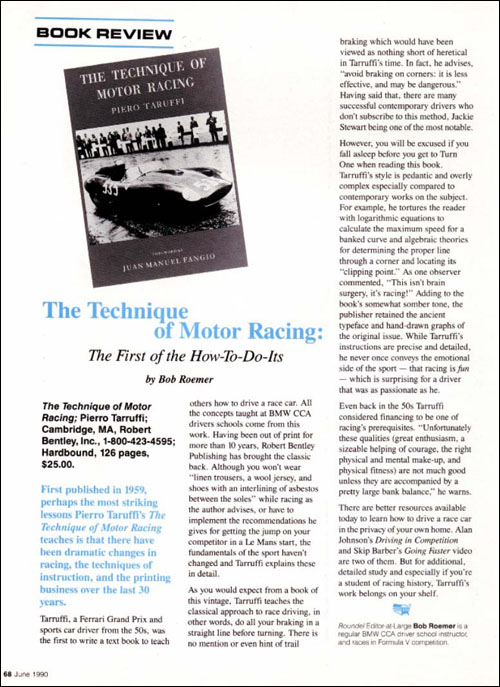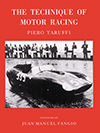Foreword by Juan Manuel Fangio |
The Technique of Motor Racing
Price: $55.00
|

Roundel - June 1990
Review of The Technique of Motor Racing from Roundel, June 1990
The Technique of Motor Racing: The First of the How To-Do-Its
"First published in 1959, perhaps the most striking lessons Piero Taruffi's The Technique of Motor Racing teaches is that there have been dramatic changes in racing, the techniques of instruction, and the printing business over the last 30 years.
Taruffi, a Ferrari Grand Prix and sports car driver from the 5Os, was the first to write a text book to teach others how to drive a race car. All the concepts taught at BMW CCA drivers schools come from this work. Having been out of print for more than 10 years, Robert Bentley Publishing has brought the classic back. Although you won't wear "linen trousers, a wool jersey, and shoes with an interlining of asbestos between the soles" while racing as the author advises, or have to implement the recommendations he gives for getting the jump on your competitor in a Le Mans start, the fundamentals of the sport haven't changed and Taruffi explains these in detail.
As you would expect from a book of this vintage, Taruffi teaches the classical approach to race driving, in other words, do all your braking in a straight line before turning. There is no mention or even hint of trail braking which would have been viewed as nothing short of heretical in Taruffi's time. In fact, he advises, "avoid braking on corners: it is less effective, and may be dangerous." Having said that, there are many successful contemporary drivers who don't subscribe to this method, Jackie Stewart being one of the most notable.
However, you will be excused if you fall asleep before you get to Turn One when reading this book. Taruffi's style is pedantic and overly complex especially compared to contemporary works on the subject. For example, he tortures the reader with logarithmic equations to calculate the maximum speed for a banked curve and algebraic theories for determining the proper line through a corner and locating its "clipping point." As one observer commented, "This isn't brain surgery, it's racing!" Adding to the book's somewhat somber tone, the publisher retained the ancient typeface and hand-drawn graphs of the original issue. While Taruffi's instructions are precise and detailed, he never once conveys the emotional side of the sport - that racing is fun - which is surprising for a driver that was as passionate as he.
Even back in the 50s Taruffi considered financing to be one of racing's prerequisites. "Unfortunately these qualities (great enthusiasm, a sizeable helping of courage, the right physical and mental make-up, and physical fitness) are not much good unless they are accompanied by a pretty large bank balance," he warns.
There are better resources available today to learn how to drive a race car in the privacy of your own home. Alan Johnson's Driving in Competition and Skip Barber's Going Faster video are two of them. But for additional, detailed study and especially if you're a student of racing history, Taruffi's work belongs on your shelf."
?Bob Roemer, Roundel Editor-at-Large

Roundel, June 1990, p68
![[B] Bentley Publishers](http://assets1.bentleypublishers.com/images/bentley-logos/bp-banner-234x60-bookblue.jpg)
